Why I Stopped Designing Video Games
It is no real secret that making video games is a complex and intense process – whether you're creating a simple platformer or something as robust as an MMORPG. This complexity begins first and foremost at the idea stage where the life essence of all video game projects begins. As much as some people might wish it, though, simply thinking of an idea doesn't make a video game come into existence.
So, what is an aspiring video game maker supposed to do once they have the idea? This is where the story of game design begins, a fascinating subfield of game development that is crucial to the entire process. In this article, we'll explore what game design even is at the very foundation, how game design exists as a career, and help you understand why it is so critical to the world of game development at large. We'll also provide you with a ton of resources so you can learn the "how" of game design too and apply it to your projects!
Defining Game Design
In this first section, we're going to take a look, first and foremost, at what game design is at the most base of levels. This will not only establish a good foundation as we explore how game design functions as a career, but also help out beginners coming in not quite sure how to define it!

What Game Design is
Game design can be considered the planning arm of the entire process for making a video game. No video game gets made without a plan, and game design is, more or less, the process of making that plan. The field is somewhat a hybridization of creativity and technical skills that combine into a cohesive, fleshed out idea that people can work with using concrete and actionable tasks.
However, that is a lot to unpack, so let's break everything down a bit more in layman's terms.
Creative Side
As mentioned, all video games start with an idea. This idea can simply be something like:
- "I want to make a platformer where the princess is the player character."
- "I will make a choice-based story RPG set in a Lovecraftian inspired world."
- "I think it'd be cool if there was a one-hit kill battle royale video game."
What the idea is doesn't particularly matter, but the point is that these are the sparks that kickstart the game design. From there, though, this idea is not enough yet to make a video game. Instead, we're left with a lot of questions. What does the princess player character look like? How are "choices" presented in the video game – dialogue or implemented in the gameplay itself? How can a one-hit kill video game be balanced for fun rather than frustration – and is it multiplayer or singleplayer? What sorts of weapons and/or items are available in these video games? Do these video games have some deeper story?
We can certainly go on and on with these questions, yet what you may not realize is answering these questions is a large part of what game design is about! These are the exact elements that help you design the game – from the characters and plot, to the design of the levels, to the mechanics of how the video game is played, to the expression of the mechanics in a way that is fun, and even to aesthetics. Every little aspect like this must be answered, and game designers are the ones to do just that. In essence, they take that base idea, and create a narrative out of it – just a specific one that helps elaborate on what elements need to be decided on and made piece by piece to make the whole puzzle of a game come together.

Technical Side
However, as creative as this might all sound, we can't neglect to elaborate on why game design is also still a technical field.
On the one hand, most game designers are actually expected to know a bit of programming, computer science, and math. While in bigger teams they might not be expected to program at all, they do need to have the background knowledge to oversee the game's production. After all, if a programmer on the team makes something that doesn't test well, the game designer is going to have a hard time communicating the technical problem unless they are familiar with the game's construction. So, having the necessary technical background will, at the very least, make communication easier as you polish and finetune the game design.
This is not to mention that many different game genres require pretty intense math and balancing. For example, if you're making a city-building strategy game, you need to be able to plan costs, plan resources, plan timetables for construction or resource gains, and so forth. This will need to be tested, rebalanced, tested again, rebalanced again, and so forth. In order to do these tasks, as well as make the initial formulas, a strong understanding of math is needed.
Beyond this, game design can also be a lot about some of the humdrum business aspects as well, including things like planning the game around the target audience. For example, according to GameRefinery, while realism is the preferred graphic style in the west for mobile games, Japan prefers anime-styled art across the board for their video games. So, depending on which market you were targetting, the art style choices of the game design might change drastically given that. While definitely not the most creative, these still are important factors to consider during the planning process.
Summary
Overall, game design is one part creativity with deciding the atmosphere, story, and aesthetics of the video game, and one part technical know-how deciding game mechanics, balancing, and so forth. Game design is a robust field of study that involves just as much knowing how and why to do a certain thing as it is using your imagination to create novel possibilities. However, no matter which side you talk about, game design is about creating the initial plan, knowing the tools and techniques to create that plan, and how that will dictate how the full game comes together as one experience.
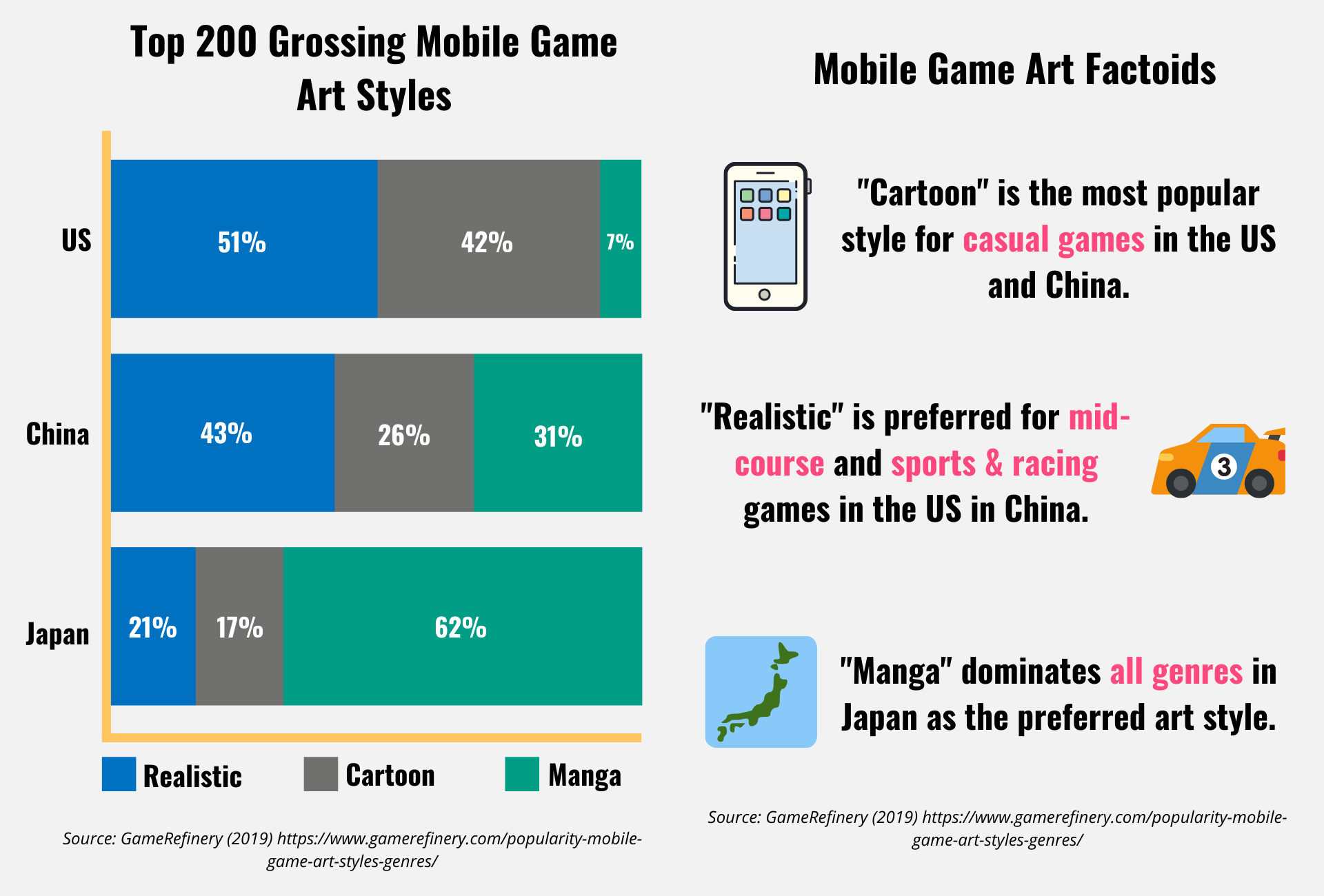
Differences from Game Developer
Before we move on to talking about game designers as a professional career, let's stop for a moment to talk about the elephant in the room. In other words, how does a game designer differ from a game developer?
This is a tricky question, as it depends on each game designer's personal situation, some nuanced technicalities, and the exact context in which each term is used. However, we can try to break it down as best we can.
First and foremost, most game designers can be considered game developers. Rather than being entirely separate, game design can be considered a subfield of the entire game development process. Generally, even for something like a UX/UI designer for a game, these subfields still encompass people considered to be game developers at the heart of the issue. Certainly, they have specialties, but they're still part of the development team.
That being said, when most people are using the term "game developer", they are generally speaking not of the specific subfields, but of the general programmers who work with the designer and plan out the super technical aspects like data structures, objects, and so forth. It's also assumed these developers have a good grasp of computer science in comparison to other specialities. We go more into depth on the entire field of game developer in this article, but the important point here is the context of how the terms are used generally refer to different things entirely – one about planning and one about programming.
Then again, it is worth pointing out that in the indie sector, where many video games are solo developed, the game designer can also be the sole "game developer" in charge of everything. As such, there is some huge crossover in activities. No game is made without a plan, so someone at some point has to do the game design.
All in all, though, the best way to navigate the world is to focus on game design as a specific subfield rather than focus on the differences. At the end, everyone involved in making a game is an important member of the game development process.

Game Design as a Career
Now that we understand what game design is, let's dive into the actual practice of it as a career. Even if you're only interested in video games as a hobby, this still may be a worthwhile section to explore just to get an understanding of a game designer's everyday life – as game design is not all fun and games. It may also give you some insight into what awaits you should you make that critical decision to start this career path.
Activities
To begin, we'll start by talking about the sorts of activities a professional game designer might do. With your new understanding of game design, many of these will be no surprise. However, before proceeding, let's establish one thing: every game designer, video game, and game development studio is different. Some activities on this list a video game designer may never touch depending on the makeup of the team and what the video game is (as different types of video games need different things), whereas others might do all of them and then some. So, be sure to consider this when deciding if this is the right career for you or not!
- Script/story writing: If a story is involved with the game, a game designer might spend a lot of time working on those aspects. This includes establishing the setting and history, establishing characters and their backstories, planning out the narrative plot, and potentially writing all the dialogue that will be used throughout the game. In larger teams, the game designer may simply coordinate with dedicated writers to get some or all of these various aspects done. Nevertheless, a game designer will often be intimately involved in getting the story off the ground.
- Planning and creating game art: Part of a game designer's duties is to decide the game's aesthetics. This can include creating basic character designs, environment visual designs, and so forth. Technical decisions will also be made here, such as whether to do pixel-art, 3D graphics, etc. Now in some cases, a game designer will make a basic concept, which they then turn over to a professional game artist to flesh out into a usable piece for relay to asset creators. In other cases, the game designer's own art may serve as the final concept art from which the game assets are made.
- Designing levels/puzzles/challenges: One thing almost all video games have in common is that there are "levels" – i.e. spaces where the game is played. Even if a single-level game – for example, a fighting game stage – every block, aesthetic, and critical path will be planned out by the game designer. This can also include planning out battle encounters, puzzles, and similar should the specific game call for that. Besides planning, a game designer may also be one of the main members implementing the levels into the game by placing assets and so forth – allowing them to tweak things as they go to create the best game possible.

- Planning interfaces: If there is no dedicated UI/UX designer on the team, guess what falls to the game designer? Whether an inventory screen, some sort of video game encyclopedia, health and hunger bars, or even simply a text score, all these interfaces need to be planned to exist, placed strategically, and have their aesthetic design decided on. Game designers will spend a huge amount of time designing this aspect, as it is one of the main ways players interact and receive information from a video game.
- Developing gameplay: As mentioned earlier, one of the main things video game designers do, even more so than the activities above, is decide on the exact mechanics of the game and how it is played. Even if it's just how fast a player character jumps, a game designer will serve a critical role in deciding these aspects. This process usually begins with a game designer writing a Game Design Document so everything is laid out, whether for just them or for a larger team. From there, a game designer will tweak the design further so every minute detail presents well and feels good as a player plays through the game.
- Collaboration and communication: Depending on team size, another activity video game designers might do in the professional world has to do with both collaboration and communication. In the previous activities, we discussed how in some cases, a video game designer may delegate certain tasks to specific specialists. When that is the case, a game designer will spend a lot of time communicating and collaborating with those team members to make sure everything created – whether that be art or the programming itself – fits the specifications of the design.
- Programming: Once again, this activity depends entirely on the situation. However, many game designers do participate at least somewhat in the programming activities of the video game. This can range from very literally doing it themselves, to simply helping out other programmers and overseeing certain technical aspects so it is a match for what the designer intended. At the very least, some programming knowledge is helpful even if you don't do it, since some aspects of game design are reliant on the technical limitations.
- Testing and changing: Finally, and a big one for video game designers, is testing and changing the video game they're working on. Besides being fun, video games at their heart are supposed to have a consistent, quality experience. Game designers will spend a long time testing every aspect of the video game to test how it feels to play, whether there are any mechanics that are broken or ruin the competitive nature of the video game, and so forth. Once those issues are discovered, they help tweak the game design until the final video game product is the very best it can be as far as the core design goes.

Job Outlook & Salary
While job availability will always vary depending on location and experience, game design can be a lucrative career to get into. According to Career Explorer, the United States alone has nearly 300,000 positions for game design. Their sources estimate that this will grow from 2016 to 2026 by 9.3%. Other sources, such as DegreeQuery which gathers information from the United States Bureau of Labor Statistics, put the job growth anywhere from 4% to 10% depending on specific data used. These sources also indicate that game designers who specialize in mobile games will often have more ample job opportunities going forward.
On the salary front, even junior designers can expect to earn quite a bit. Without considering specializations, the job sites below reported the following salary ranges for game designers in the US:
- PayScale: $40K to $103K (Average of $66,362)
- Glassdoor: $39K to $86K (Average of $$74,119)
- CareerExplorer: $47.4K to $172.1K (Average of $90,270)
Salaries might also vary greatly by company. For example, PayScale shows Bungie having the lowest salary for game designers at $61K, while Age of Learning, Inc. and Electronic Arts both pay over $85K for their game designers. Experience can also play a big role, with developers seeing an average of $10,000 more per year for every 1-5 years more experience they possess.
As you can see, though, game design is both in-demand and a profitable field to pursue. Further, game design can be even more profitable as you specialize, especially for things like UI/UX design.
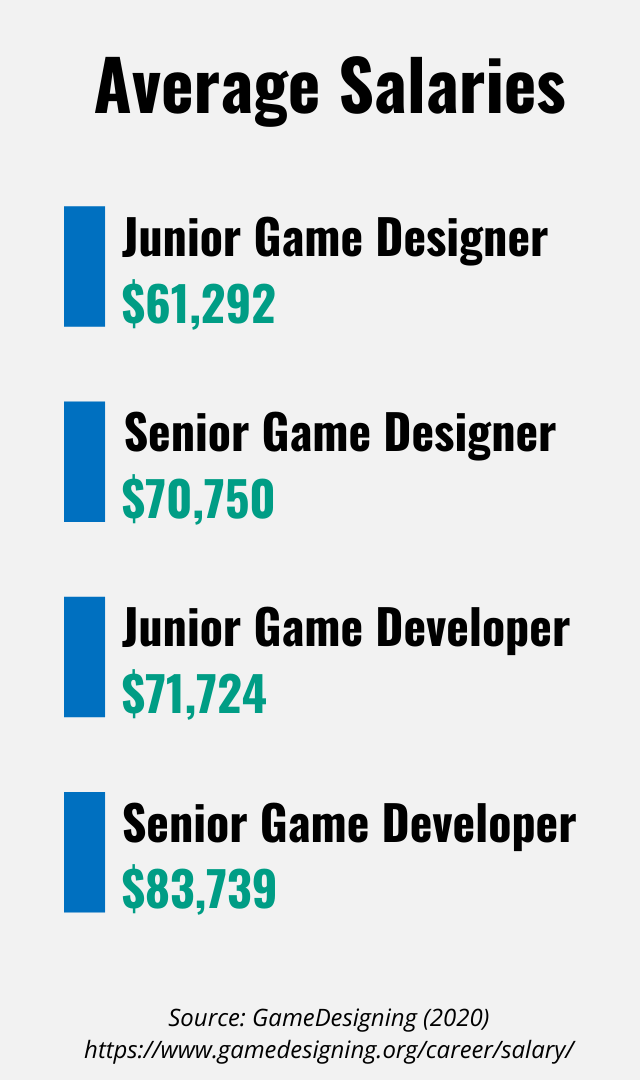
Becoming a Video Game Designer
By this point, not only should you have a good idea about what game design is, but also maybe you want to become one now – whether that means joining a professional AAA company or simply solo-developing some video games as a hobby. Whatever your ultimate goals, though, we've compiled some of our tips and resources to help you take the first steps on this amazing journey and master game design!
Get the Technical Skills
We've long since established that game design is not just about having creative ideas – it's also about technical skills and knowing how and why to do certain game design things (not to mention knowledge of computer science).
So, obviously, the first step here is to get some technical skills and master the basics, both of game design and its many facets, and of programming. We've broken some helpful tutorials and online courses below to get you started on your journey.
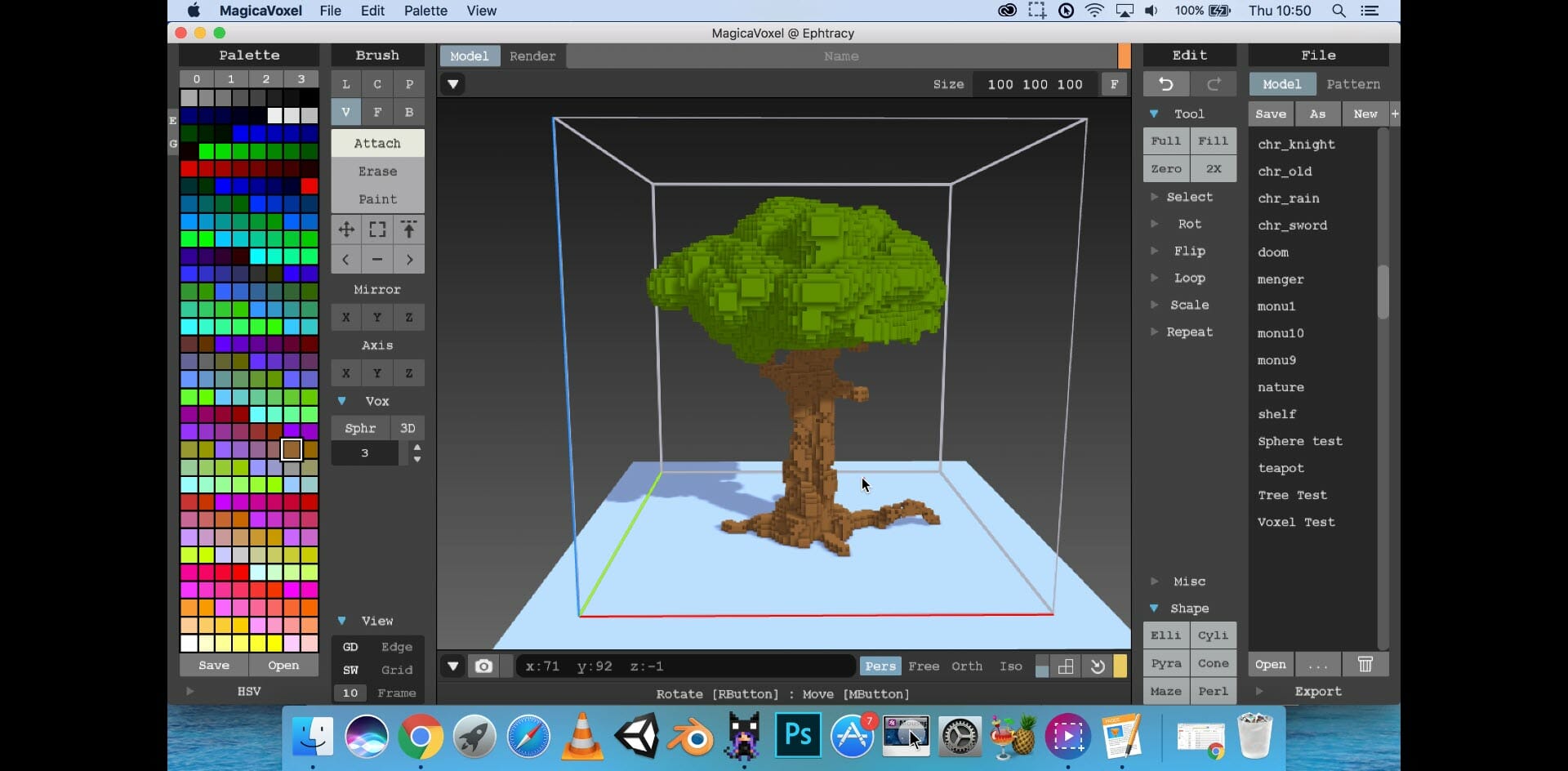
Programming
- Best Programming Languages to Learn to Code by Lindsay Schardon
- What is Coding and Why Learn to Code?
- (Premium) Python Mini-Degree by Zenva
- (Premium) Full-Stack Web Development Mini-Degree by Zenva
- (Premium) C++ Programming Bundle by Zenva
- (Premium) Mobile App Development Mini-Degree by Zenva
- (Premium) Unity Game Development Mini-Degree by Zenva
- (Premium) Intro to Programming Bundle by Zenva
- Coding 101 Bundle – Programming Essentials by Zenva
- Python Tutorial for Absolute Beginners by CS Dojo
- JavaScript Tutorial For Beginners by The Net Ninja
- C# Basic Series by Allan Carlos Claudino Villa
- How to Program in C# by Brackeys
- C++ Programming All-in-One Tutorial Series by Caleb Curry
- Zero-Day Java Guide by Mohit Deshpande
- Swift Tutorial Series by Mohit Deshpande
General Game Design
- (Premium) Intro to Game Design by Zenva
- How to Make a Game by Daniel Buckley
- How to Design a Game: Game Design Documents by Tim Bonzon
- Basic Principles of Game Design – by Brackeys
- 7 Must Read Books for Game Designers
- Game Design Document Template – by Game Dev Underground
- Our 50 Favorite Game Design Tutorials by Game Designing
- Making Your First Game: Basics – How To Start Your Game Development by Extra Credits
- Game Design Process: Designing Your Video Game by Ask Gamedev
- 51 Game Design Tips! (In 8 Minutes) by Jonas Tyroller
- How to Improve Game Feel in Three Easy Ways by Ji-Young Kim
Game Art
- (Premium) Game Artwork Academy by Zenva
- Unity Animator Tutorial – Comprehensive Guide by Tim Bonzon
- A Guide to Handling Huge Worlds in Unity by Renan Oliveira
- Unity Animation for Beginners by Tim Bonzon
- 5 Steps To Making A Gorgeous 2D Game by Thomas Brush
- How Do We Make Video Game Art, Again? by ConceptArtHouse
- Making Concept Art Character Designs for A Video Game! by The Poncho Pilgrim
- Things To Know About Game Art and College by DeepFriedPaint
- Game Design School: Character Design by Pixel Pete
Game Writing
- How to Approach Narrative Game Design by Cypress Reeves
- So You Want to Write for Video Games? by Ken Miyamoto
- How to Become a Video Game Writer
- A Practical Guide to Game Writing by Gamesutra
- The Three Pillars of Game Writing – Plot, Character, Lore by Extra Credits
- How To Start Your Game Narrative – Design Mechanics First by Extra Credits
- Bad Writing – Why Most Games Tell Bad Stories by Extra Credits
- Storytelling in Video Games by Brackeys
- How to Make a HIT Indie Game (Story-Driven) / "The Formula" by PieNinjaProductions
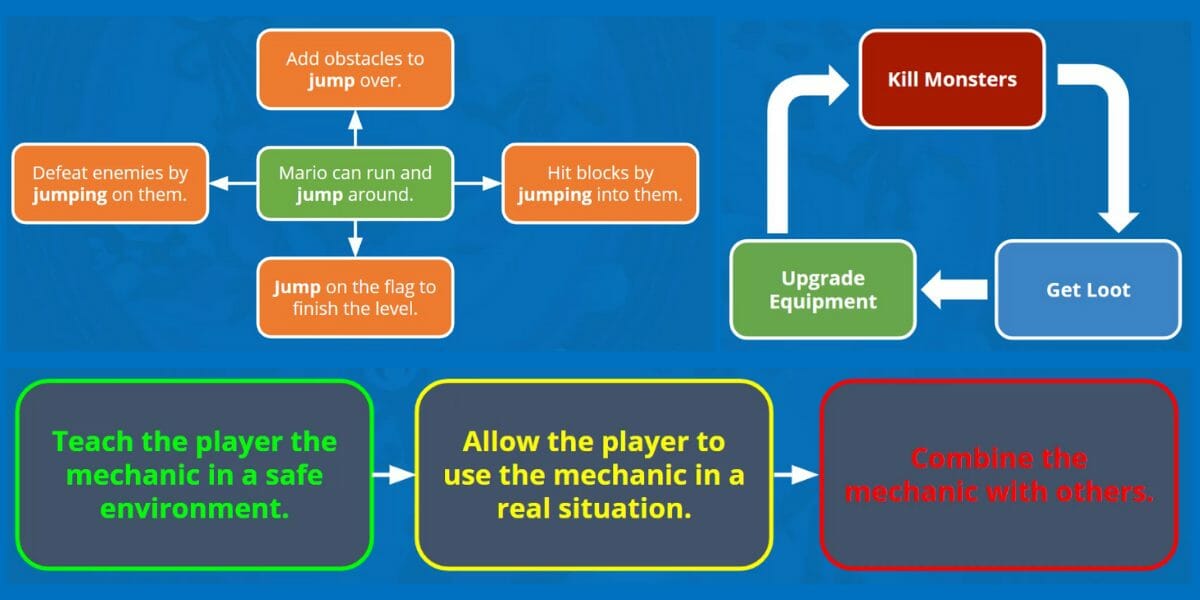
Make a Video Game
Once you have the basics down, the next step in the journey to becoming a game designer would be to simply put it in practice and make your own games. This not only allows you to practice your skills, but also lets you build a portfolio which is crucial if you're trying to get hired. Plus, as we've established above, game design is an expansive field that is about game mechanics, UIs, and more. So the more opportunities you put each aspect of game design into practice, the more you'll find what works from you.
Below we've compiled some of our favorite resources that will help you make your first video game. Keep in mind, we've also included some non-computer games in this list as well, since game design principles (like good mechanics) are still as relevant to board games, card games, and so forth. Also, don't forget to expand past these tutorials as well – game design is about experimentation!
- (Premium) Create Your First 3D Game in Unity by Zenva
- (Premium) Create Your First 2D Game in Unity by Zenva
- 3D Game Development 101 – Create a Basketball Game by Zenva
- Build a Road Crossing Game with Unreal by Daniel Buckley
- Create a Unity FPS in 3 Hours by Zenva
- Create a Unity RPG in 4 HOURS by Zenva
- How To Create A Game Using JavaScript by Dani Krossing
- C++ Tutorial 18 – Simple Snake Game by NVitanovic
- Java Programming: Let's Build a Zombie Game #1 by RealTutsGML
- How to Make a Game by Daniel Buckley
- Coding for Kids: Languages and Project Ideas by Lindsay Schardon
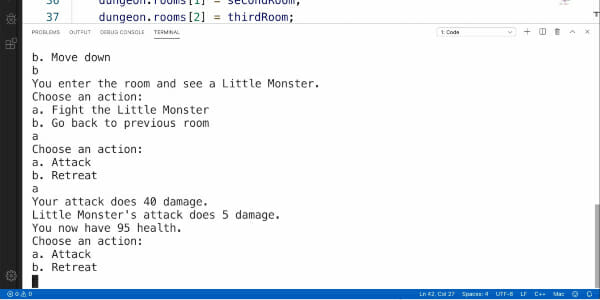
Conclusion
By this point, we hope you have a good idea of what game design is. Game design is an essential component to all games no matter how large or how small. Without game design, projects would fall through quickly. With a concrete plan, though, any developer can bring a project into reality.
Additionally, game design is recognized as an important position in larger companies, with high salaries and a need for the in-demand skillsets involved. It is not just thinking of ideas, but understanding how to logically and systematically arrange those ideas in a way that produces a fun game.
All this being said, we've only just scratched the surface here. There are a lot of skills involved with game design – from understanding how to guide players, to understanding high-level concepts like game loops. However, with the resources provided, you can definitely dive deep into the field. Maybe you'll even make the next hit game. 😉
Don't miss out! Offer ends in
- Access all 200+ courses
- New courses added monthly
- Cancel anytime
- Certificates of completion
Related Posts
Why I Stopped Designing Video Games
Source: https://gamedevacademy.org/what-is-game-design/
Posted by: fernandezheratat.blogspot.com

0 Response to "Why I Stopped Designing Video Games"
Post a Comment